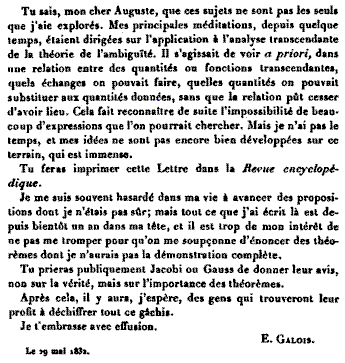Théorie de l'Ambiguité
According to a 2008 paper by Yves André of the École Normale Supérieure of Paris—
"Ambiguity theory was the name which Galois used
when he referred to his own theory and its future developments."
The phrase "the theory of ambiguity" occurs in the testamentary letter Galois wrote to a friend, Auguste Chevalier, on the night before Galois was shot in a duel.
Hermann Weyl in Symmetry, Princeton University Press, 1952—
"This letter, if judged by the novelty and profundity of ideas it contains, is perhaps
the most substantial piece of writing in the whole literature of mankind."
Conclusion of the Galois testamentary letter, according to
the 1897 Paris edition of Galois's collected works—

The original—
A transcription—
Évariste GALOIS, Lettre-testament, adressée à Auguste Chevalier—
Tu sais mon cher Auguste, que ces sujets ne sont pas les seuls que j'aie
explorés. Mes principales méditations, depuis quelques temps,
étaient dirigées sur l'application à l'analyse transcendante de la théorie de
l'ambiguité. Il s'agissait de voir a priori, dans une relation entre des quantités
ou fonctions transcendantes, quels échanges on pouvait faire, quelles
quantités on pouvait substituer aux quantités données, sans que la relation
put cesser d'avoir lieu. Cela fait reconnaitre de suite l'impossibilité de beaucoup
d'expressions que l'on pourrait chercher. Mais je n'ai pas le temps, et mes idées
ne sont pas encore bien développées sur ce terrain, qui est
immense.
Tu feras imprimer cette lettre dans la Revue encyclopédique.
Je me suis souvent hasardé dans ma vie à avancer des propositions dont je n'étais
pas sûr. Mais tout ce que j'ai écrit là est depuis bientôt un an dans ma
tête, et il est trop de mon intérêt de ne pas me tromper pour qu'on
me soupconne d'avoir énoncé des théorèmes dont je n'aurais pas la démonstration
complète.
Tu prieras publiquement Jacobi et Gauss de donner leur avis,
non sur la vérité, mais sur l'importance des théorèmes.
Après cela, il y aura, j'espère, des gens qui trouveront leur profit
à déchiffrer tout ce gachis.
Je t'embrasse avec effusion.
E. Galois Le 29 Mai 1832
A translation by Dr. Louis Weisner, Hunter College of the City of New York, from A Source Book in Mathematics, by David Eugene Smith, Dover Publications, 1959–
You know, my dear Auguste, that these subjects are not the only ones I have explored. My reflections, for some time, have been directed principally to the application of the theory of ambiguity to transcendental analysis. It is desired see a priori in a relation among quantities or transcendental functions, what transformations one may make, what quantities one may substitute for the given quantities, without the relation ceasing to be valid. This enables us to recognize at once the impossibility of many expressions which we might seek. But I have no time, and my ideas are not developed in this field, which is immense.
Print this letter in the Revue Encyclopédique.
I have often in my life ventured to advance propositions of which I was uncertain; but all that I have written here has been in my head nearly a year, and it is too much to my interest not to deceive myself that I have been suspected of announcing theorems of which I had not the complete demonstration.
Ask Jacobi or Gauss publicly to give their opinion, not as to the truth, but as to the importance of the theorems.
Subsequently there will be, I hope, some people who will find it to their profit to decipher all this mess.
J t'embrasse avec effusion.
E. Galois. May 29, 1832.
Translation, in part, in The Unravelers: Mathematical Snapshots, by Jean Francois Dars, Annick Lesne, and Anne Papillaut (A.K. Peters, 2008)–
"You know, dear Auguste, that these subjects are not the only ones I have explored. For some time my main meditations have been directed on the application to transcendental analysis of the theory of ambiguity. The aim was to see in a relation between quantities or transcendental functions, what exchanges we could make, what quantities could be substituted to the given quantities without the relation ceasing to take place. In that way we see immediately that many expressions that we might look for are impossible. But I don't have the time and my ideas are not yet developed enough in this vast field."
Another translation, by James Dolan at the n-Category Café—
"My principal meditations for some time have been directed towards the application of the theory of ambiguity to transcendental analysis. It was a question of seeing a priori in a relation between quantities or transcendent functions, what exchanges one could make, which quantities one could substitute for the given quantities without the original relation ceasing to hold. That immediately made clear the impossibility of finding many expressions that one could look for. But I do not have time and my ideas are not yet well developed on this ground which is immense."
Related material—
"Renormalisation et Ambiguité Galoisienne," by Alain Connes, 2004
"La Théorie de l’Ambiguïté : De Galois aux Systèmes Dynamiques," by Jean-Pierre Ramis, 2006
"Ambiguity Theory, Old and New," preprint by Yves André, May 16, 2008,
"Ambiguity Theory," post by David Corfield at the n-Category Café, May 19, 2008
"Measuring Ambiguity," inaugural lecture at Utrecht University by Gunther Cornelissen, Jan. 16, 2009
